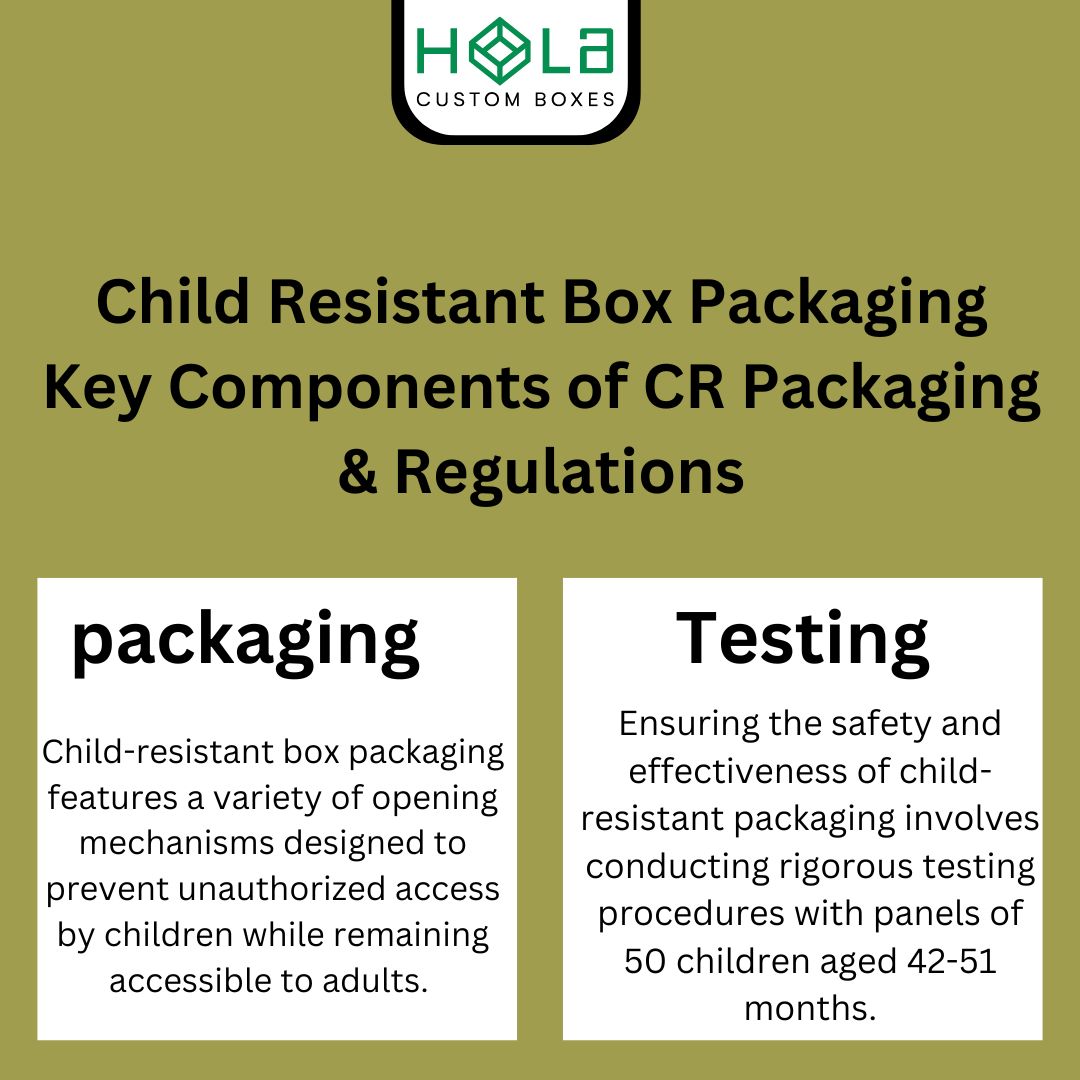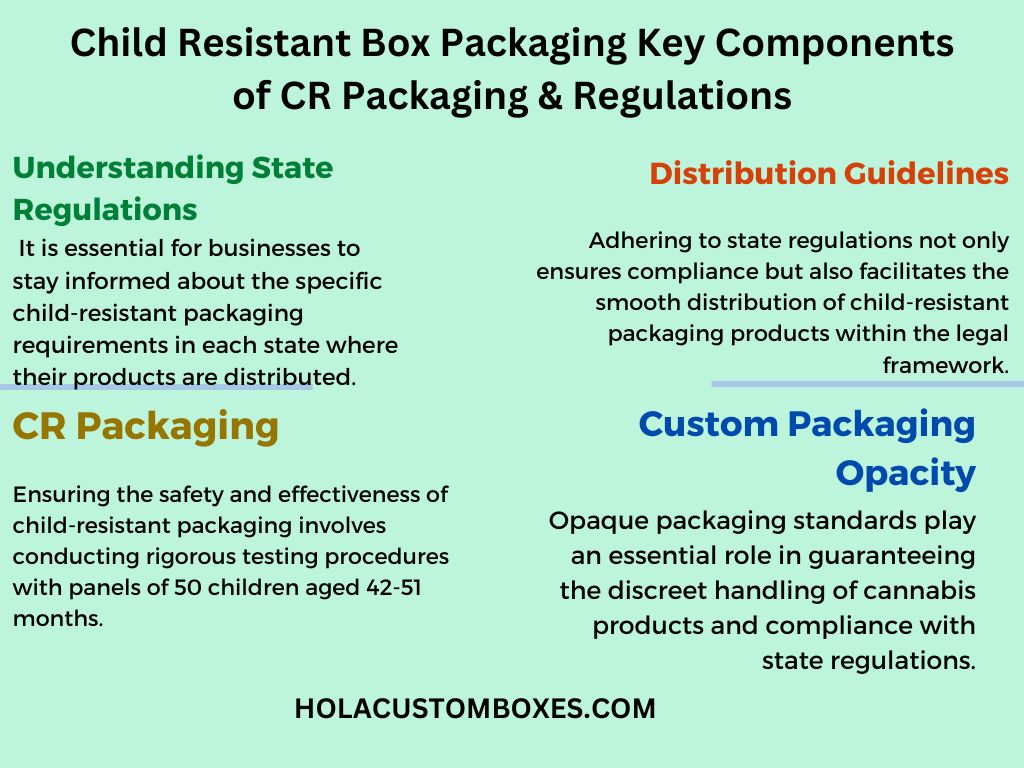Child Resistant Box Packaging Key Components of CR Packaging & Regulations
2025-08-11 14:16:09
Child Resistant (CR) packaging includes innovative opening mechanisms and stringent testing procedures to safeguard children. Specific messaging and labeling requirements inform consumers of potential hazards. Opaque packaging ensures discreet handling of products. State regulations compliance is important to avoid penalties. Understanding key components like these is essential for businesses seeking to comply with safety standards and regulations in the packaging industry.
Main Points
- Child-resistant box packaging features various opening mechanisms to prevent unauthorized access.
- Labeling requirements include warning labels to inform consumers of potential hazards.
- CR packaging testing involves panels of 50 children aged 42-51 months.
- Opaque packaging standards ensure discreet handling of cannabis products.
- Compliance with state regulations is crucial to avoid penalties and legal repercussions.
Opening Mechanism Overview Of Custom CR Packaging

Child-resistant box packaging features a variety of opening mechanisms designed to prevent unauthorized access by children while remaining accessible to adults. These opening mechanisms, such as child-resistant lids on medications, often require specific actions like downward pressure and counter-clockwise twisting simultaneously. CR packaging guidelines frequently require the packaging itself to have a child-resistant design, ensuring that the opening mechanism is challenging for children but easy for adults to navigate. Various types of child-resistant opening mechanisms exist, all aimed at impeding children under five from accessing potentially harmful products.
Regulatory bodies closely monitor the effectiveness of these opening mechanisms to guarantee the safety of children. The primary goal of child-resistant packaging is to create a barrier that deters young children from opening packages containing dangerous substances. By implementing these child-resistant designs, manufacturers can provide an additional layer of protection for children while still allowing adults easy access to the contents.
Messaging and Labeling Requirements Of Custom CR Boxes

In considering the safety measures associated with box packaging, one pivotal aspect that demands meticulous attention is the adherence to messaging and labeling requirements. Labeling requirements for child-resistant packaging encompass essential information such as THC levels, dosages, and strain type, particularly for cannabis products.
Warning labels play a significant role in emerging markets like cannabis, as they inform consumers of potential hazards and risks. These labels must be explicit and informative to assist consumers in protecting themselves and children from harm. Messaging on packaging must comply with ever-changing labeling standards in the cannabis industry to guarantee consumer safety.
Proper labeling on child-resistant packaging not only helps consumers make informed decisions but also aids in maintaining a safe environment. By following packaging guidelines and incorporating informative labels with clear messaging standards, child access to potentially harmful substances can be minimized, promoting a safer consumer experience.
CR Packaging Testing Procedures
Ensuring the safety and effectiveness of child-resistant packaging involves conducting rigorous testing procedures with panels of 50 children aged 42-51 months. These testing procedures are vital to meet the regulations outlined in 16 CFR §1700.20(a)(2)(iii) and guarantee that the packaging is difficult for children to open within the specified time frame, typically 10 minutes.
Here are key aspects of CR packaging testing:
Panel Composition: Panels consist of 50 children within the specified age range to evaluate the packaging's child-resistant capabilities.
Passing Criteria: The packaging must prove to be challenging for children to open within the designated time frame to meet the testing requirements.
Inconclusive Results: In cases of inconclusive results, a maximum of 200 children may be tested to determine the packaging's effectiveness further.
Safety Assurance: Testing aims to certify that the child-resistant packaging effectively prevents unauthorized access by children, ensuring product safety and compliance with regulatory standards.
Why Packaging Matters in a Crowded Market
In today’s fast-paced and competitive marketplace, brands need more than just a great product to get noticed—they need packaging that captivates. Custom boxes with logos have the power to turn ordinary items into irresistible must-haves. From vibrant colors that catch the eye to unique shapes that spark curiosity, every design choice can make your brand stand out. Premium materials convey quality, while consistent branding builds trust and loyalty.
Turning Packaging into a Brand Experience
Memorable packaging doesn’t just protect your product—it tells a story and creates an emotional bond with customers. When your design resonates, it inspires sharing, strengthens brand recognition, and makes it easier for consumers to choose you over competitors. In a world full of options, great packaging can be the difference between blending in and shining brightly on the shelves.
State Regulations Compliance Of Custom Boxes
Compliance with varying state regulations regarding child-resistant packaging is paramount for businesses operating within the cannabis industry. To guarantee adherence to state regulations, businesses must consider the following key components:
Understanding State Regulations: It is essential for businesses to stay informed about the specific child-resistant packaging requirements in each state where their products are distributed.
Compliance and Testing Procedures: Businesses need to follow the prescribed testing procedures outlined by each state to make sure that their packaging meets the necessary child-resistant standards.
Penalties and Legal Consequences: Failure to comply with state regulations can lead to penalties and legal repercussions, impacting the reputation and operations of the business.
Distribution Guidelines: Adhering to state regulations not only ensures compliance but also facilitates the smooth distribution of child-resistant packaging products within the legal framework.
